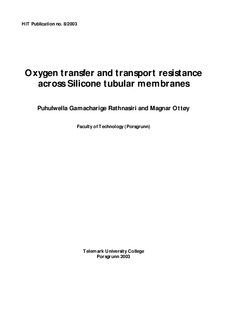| dc.contributor.author | Rathnasiri, Puhulwella Gamacharige | |
| dc.contributor.author | Ottøy, Magnar | |
| dc.date.accessioned | 2006-10-12T09:02:24Z | |
| dc.date.accessioned | 2017-04-19T13:28:01Z | |
| dc.date.available | 2006-10-12T09:02:24Z | |
| dc.date.available | 2017-04-19T13:28:01Z | |
| dc.date.issued | 2003 | |
| dc.identifier.issn | 1503-3767 | |
| dc.identifier.uri | http://hdl.handle.net/11250/2439179 | |
| dc.description.abstract | Dissolved oxygen is used as an electron acceptor in aerobic organic waste digestion in biological processes. To enhance production of intermediate metabolic products such as acetate in anaerobic conversion, small amounts of oxygen is needed. The process is then called combined microaerobic and anaerobic. One strategy of supplying oxygen is to dissolve it in water and transfer it across a dense polymeric membrane to the biological medium. Thus experimental data on oxygen flux and flow resistance are needed. In this study, an experimental method is proposed to determine the transport rates and total resistance of flow across silicone tubular membranes by using bulk oxygen concentration measurements. The biological medium inside the reactor is replaced by a known volume of distilled water. Dissolved oxygen is removed from the distilled water by purging nitrogen gas. Water to be circulated inside the membrane is saturated with oxygen by purging either with pure oxygen or air. This oxygen saturated water is supplied to the reactor by flushing inside the silicone tube. Experiments with different temperatures inside and outside the tubular membranes are also performed. Variations of bulk oxygen concentrations with time inside the reactor are measured using calibrated microelectrodes. At room temperature, both thin and thick membranes produced the lowest oxygen transfer rate when water saturated with air was supplied inside the membranes. The highest oxygen transfer rates were reported when pure air (not dissolved in water) was supplied inside the membrane. When the reactor was held at 550C, both membranes showed a reduction of oxygen transfer rates compared to the room temperature experiments. Results obtained can be used as a tool to screen different membrane design options and estimate oxygen supply rates in membrane integrated biological processes. | |
| dc.format.extent | 161012 bytes | |
| dc.format.mimetype | application/pdf | |
| dc.language.iso | eng | |
| dc.publisher | Høgskolen i Telemark | |
| dc.relation.ispartofseries | HiT skrift | |
| dc.subject | Dense tubular membranes | |
| dc.subject | Dissolved oxygen | |
| dc.subject | Membraner | |
| dc.subject | Biological processes | |
| dc.subject | Microaerobic | |
| dc.subject | Flow resistance | |
| dc.title | Oxygen transfer and transport resistance across silicone tubular membranes | |
| dc.type | Research report | |
| dc.description.version | Published version | |
| dc.rights.holder | © The Authors/Telemark University College | |
| dc.subject.nsi | 563 | |
